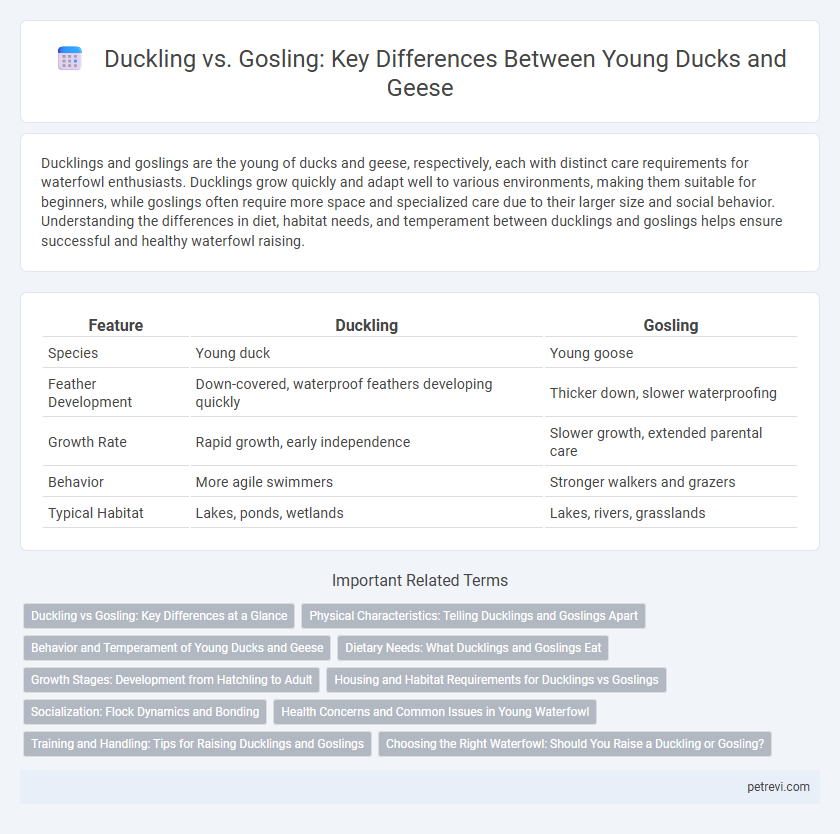Ducklings and goslings are the young of ducks and geese, respectively, each with distinct care requirements for waterfowl enthusiasts. Ducklings grow quickly and adapt well to various environments, making them suitable for beginners, while goslings often require more space and specialized care due to their larger size and social behavior. Understanding the differences in diet, habitat needs, and temperament between ducklings and goslings helps ensure successful and healthy waterfowl raising.
Table of Comparison
| Feature | Duckling | Gosling |
|---|---|---|
| Species | Young duck | Young goose |
| Feather Development | Down-covered, waterproof feathers developing quickly | Thicker down, slower waterproofing |
| Growth Rate | Rapid growth, early independence | Slower growth, extended parental care |
| Behavior | More agile swimmers | Stronger walkers and grazers |
| Typical Habitat | Lakes, ponds, wetlands | Lakes, rivers, grasslands |
Duckling vs Gosling: Key Differences at a Glance
Ducklings are the young of ducks, typically characterized by their downy feathers and short bills, while goslings are the young of geese, known for their larger size and longer necks compared to ducklings. Ducklings tend to hatch from smaller eggs and grow more rapidly, often becoming independent sooner than goslings, which require extended parental care. Behavioral distinctions include ducklings' strong swimming instincts shortly after hatching, whereas goslings exhibit more land-based activity and slower early development.
Physical Characteristics: Telling Ducklings and Goslings Apart
Ducklings typically have softer, downy feathers that are yellow or a mix of yellow and brown, while goslings often display a more uniform, grayish or duller yellow plumage. Ducklings have shorter necks and more compact bodies compared to goslings, which feature longer necks and a more elongated body shape. The bill of a duckling tends to be broader and flatter, whereas goslings have a narrower, slightly pointed bill suited for grazing.
Behavior and Temperament of Young Ducks and Geese
Ducklings exhibit curious and social behavior, often following their mother closely and engaging in rapid learning through imitation, which fosters strong flock cohesion. Goslings display more independent and cautious temperaments, showing slower adaptation to new environments but a higher degree of territoriality as they mature. Both species communicate through distinct vocalizations, with ducklings tending to be more vocal and playful, while goslings demonstrate quieter, more deliberate interactions.
Dietary Needs: What Ducklings and Goslings Eat
Ducklings primarily consume insects, small aquatic invertebrates, and plant material like algae to meet their high protein needs for growth. Goslings have a more herbivorous diet, feeding on grasses, leaves, and aquatic plants, which supports their development but requires more fibrous content. Both species rely on their environment to provide suitable food sources that align with their digestive capabilities during early life stages.
Growth Stages: Development from Hatchling to Adult
Ducklings experience rapid feather development and waterproofing in their first few weeks, transitioning from fluffy hatchlings to fully feathered juveniles ready for swimming and feeding independently. Goslings tend to grow larger and develop more slowly, with a longer period of dependence on parental care throughout early growth stages. Both species undergo significant changes in plumage and body size as they mature from hatchlings into adult waterfowl capable of flight and reproduction.
Housing and Habitat Requirements for Ducklings vs Goslings
Ducklings require warm, dry, and secure brooding environments with ample access to clean water for swimming, as their down feathers are less waterproof at an early age, while goslings thrive in larger, open grassy areas with protective shelter to support their rapid growth and grazing needs. Both species need predator-proof housing, but ducklings benefit from heated pens during the first few weeks, whereas goslings tolerate cooler temperatures and require more space for exercise. Proper habitat design includes shallow water sources for ducklings to develop swimming skills and ample forage-rich pastures for goslings to promote healthy development.
Socialization: Flock Dynamics and Bonding
Ducklings exhibit strong socialization skills, forming tight-knit flocks that enhance survival through cooperative behaviors and synchronized movement. Goslings also develop social bonds but tend to establish hierarchical structures within their groups, influencing flock dynamics differently than ducklings. Understanding these variations in bonding and social interaction is crucial for managing young waterfowl in conservation and farming contexts.
Health Concerns and Common Issues in Young Waterfowl
Ducklings and goslings face similar health concerns such as respiratory infections, parasitic infestations, and nutritional deficiencies, but goslings are more prone to leg deformities due to rapid growth. Both young waterfowl require clean, warm environments and a balanced diet rich in protein, vitamins, and minerals to prevent common issues like splay leg and coccidiosis. Early intervention and proper husbandry practices are essential to ensure the survival and healthy development of ducklings and goslings.
Training and Handling: Tips for Raising Ducklings and Goslings
Ducklings and goslings require gentle handling from an early age to build trust and reduce stress during training sessions. Consistent daily interaction, including feeding and hand-feeding techniques, promotes socialization and easier management as they grow. Providing a safe, warm environment with access to clean water encourages healthy development and supports effective training practices.
Choosing the Right Waterfowl: Should You Raise a Duckling or Gosling?
Ducklings and goslings both require specialized care, but ducklings typically adapt faster to diverse water environments, making them ideal for beginners. Goslings grow larger and need more space and a higher-protein diet, suitable for those with ample resources and experience. Choosing between a duckling or gosling depends on your ability to provide appropriate habitat, nutrition, and handling tailored to each species' growth and behavior.
Duckling vs Gosling for Young Waterfowl Infographic

 petrevi.com
petrevi.com